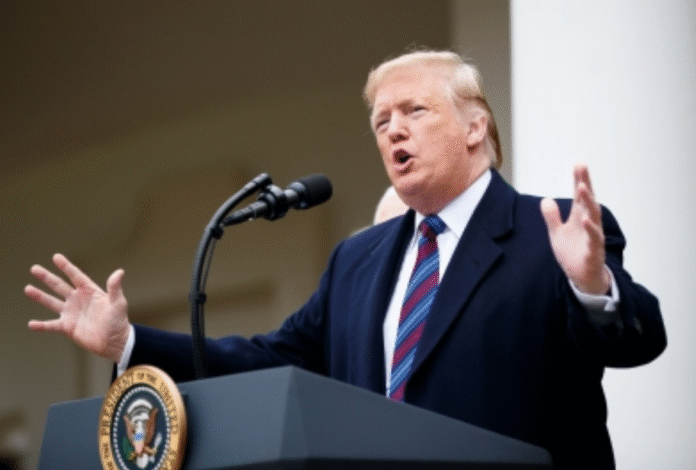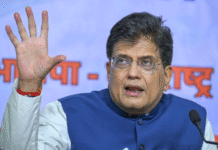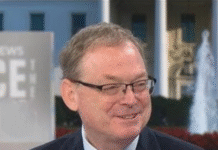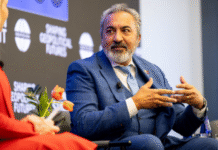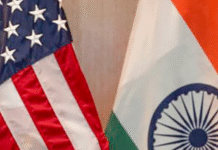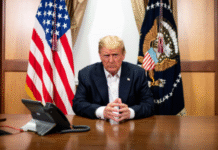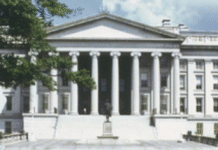New York–Pesident Donald Trump has said that the United States and India remain engaged in trade negotiations, even after he publicly threatened to impose a 25 per cent tariff on Indian imports and a separate penalty on countries buying energy from Russia. A final decision, he suggested, could be announced by the end of the week.
“We’re talking to India now — we’ll see what happens,” Trump told reporters on Wednesday, hours after making the tariff threat on his Truth Social platform. He reiterated his long-standing criticism that India imposes “one of the highest tariffs in the world,” but added that India was now “willing to cut it very substantially.”
Trump did not directly address the Russian energy penalty when asked by a reporter, instead shifting focus to a broader 10 per cent penalty he has proposed for BRICS member nations. He accused the BRICS group — which includes Brazil, Russia, India, China, and South Africa — of being “anti-United States,” calling it “an attack on the dollar.”
“India is a member of that, if you can believe it,” Trump said, referencing the BRICS grouping. “It’s partially BRICS, and it’s partially the trade.”
His comments appear to signal that the harsh rhetoric may be a strategic negotiating tactic, rather than a definitive policy announcement. Notably, no formal notification of the proposed tariffs has been issued to India, as has been done with other nations in the past.
India Responds Firmly
India reacted with defiance to Trump’s tariff threat. In a statement, the government said it would “take all steps necessary to secure our national interest,” underscoring its intent to defend domestic priorities — especially in sectors like agriculture and small business.
“The government attaches the utmost importance to protecting and promoting the welfare of our farmers, entrepreneurs, and MSMEs (Micro, Small, and Medium Enterprises),” the statement said.
Agriculture and dairy market access remain key sticking points in the ongoing negotiations. The U.S. has long urged India to open its markets to American agricultural products, a move that could affect India’s vast and politically sensitive farming sector.
A Deal Long in the Works
Trump and his administration had previously expressed optimism that India would be one of the first nations to finalize a trade agreement with the U.S., but that deal has remained elusive. India was among the earliest to begin tariff talks with Washington, and Trump has repeatedly suggested — most recently just last week — that an agreement was imminent.
India’s Commerce Minister Piyush Goyal also struck an optimistic tone recently. “I do hope we’ll be able to conclude a very consequential partnership,” Goyal said in a media interview in London last week, adding that negotiations were making “fantastic” progress.
India’s Commerce Ministry echoed that sentiment on Wednesday, saying, “India and the U.S. have been engaged in negotiations on concluding a fair, balanced, and mutually beneficial bilateral trade agreement over the last few months. We remain committed to that objective.”
Personal Ties and Political Calculus
In his remarks from the White House, Trump referred to Indian Prime Minister Narendra Modi as “a friend of mine,” a line he often uses before launching into critiques of India’s trade policies.
“It doesn’t matter too much whether we have a deal or whether we charge them a certain tariff,” he added nonchalantly. “But you’ll know at the end of this week.”
Trump also renewed his criticism of India’s import duties, claiming that while the U.S. buys heavily from India, American exports to the country are stifled by excessive tariffs — which he alleged go as high as 175 per cent.
On his Truth Social account earlier in the day, Trump accused India of continuing to rely heavily on Russia for defense and energy imports. “India has always bought a vast majority of their military equipment from Russia, and are Russia’s largest buyer of energy, along with China, at a time when everyone wants Russia to stop the killing in Ukraine,” he wrote, adding that India would face a 25 per cent tariff “plus a penalty” beginning August 1.
Whether that policy will take effect or serve as leverage in ongoing trade negotiations remains to be seen. (Source: IANS)


